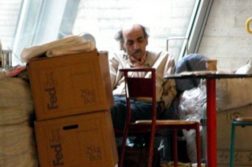In the wake of the Villawood riots, blame is being thrown in every direction: at the Minister for Immigration, Chris Bowen; at Serco, the corporation that runs the detention centre; at the extremely drawn out system for processing claims and appeals; at the detention environment and at immigration policy in general.
But it seems a majority of public anger is directed at the asylum seekers themselves. The more condemning accusations, including those coming from the Minister himself, depict disappointed asylum seekers attempting to change the outcome of their applications by holding the Department of Immigration hostage with threats and violence.
For those of us who work with asylum seekers in detention, it was clear that a situation like this was only a matter of time. Tension has been rising in the past few weeks as spates rejections were handed back to applicants who waited four to five months to receive this outcome. While reports suggest that the protesters represent a few disgruntled people acting out to get their way after rejected claims, in reality, the majority of people in detention centres on the mainland are applicants who have had their refugee status assessment process rejected. Some have appealed and have had an Immigration Merits Review, only to receive their second rejection, some even a third. They are entitled to this process of appeal just as onshore applicants are. This is in line with any other fair and legal decision making process in Australia — it is a process that safeguards against error, misjudgement and arbitrary decision making. Even people convicted of actual crimes are entitled to a process of appeal and review.
The fact of the matter is that with very few exceptions, the majority of people in detention receive their protection visas sometime during the appeal process. Many have been rejected several times before they are recognised as refugees. The process is extremely harrowing for people who have escaped from torture, trauma, loss and war. Most are forced to tell and retell stories of their own persecution, the death of loved ones and the hazardous trip they made to Australia. Even though they have escaped their countries, they wake up every day with anxiety for the future and their family’s safety.
The "waiting period" following an assessment or review has been steadily lengthening. During this period, detained asylum seekers have very little control over their own cases — they’re often left in the dark or told that there is no information and they just have to wait. Their information is taken in an interview through an interpreter, processed by a lawyer. Their cases handled by a case manager who has to divide their limited time between numerous clients. Outcomes of their claims are returned to them as lengthy documents written only in English.
Their newly acquired access to the courts is at this time a somewhat Pyrrhic victory. Most have been told by their existing lawyers that they do not deal with courts, and that they need to find a barrister. A severe shortage of lawyers means that there is a long waiting period to lodge an application, let alone get a court date. Those who have grounds for appeal know that entering into this new process will mean at least another six months in detention and as more people receive rejections, the more strain there is on resources and the longer this processing takes.
Time doesn’t stop in detention. Many have had loved ones pass away, go missing or continue to suffer persecution while they have remained locked up. Some have missed their child’s first steps or first words; some have been away from home so long their youngest child’s only memory of them is through a photograph and a voice on the phone. It is for this reason that they reach a point of despair and question why they tried to seek safety at all, having lost nearly two years of their lives locked inside without definitive end.
The rise in the number of suicides and incidents of self-harm should have been sufficient warning to the Department of the growing despair. Minister Bowen says that "Australians are sick and tired of waking up to reports of detention centres being set alight and police being attacked by rioting asylum seekers". The question is why Bowen doesn’t appear to be sick and tired of waking up to reports of another asylum seeker taking his life in an Australian detention centre. While suicide is always a tragedy, a death in detention is a travesty, because a young man who had the hope and wherewithal to flee for his life by leaving his home, arrived in Australia seeking protection, only to lose that hope and end his life, all while in our care.
I personally know some of the men who were on the roof at Villawood. One of them has just returned from a month in hospital having been sedated every day following an incident of self-harm. Another has immediate family in Sydney including a beautiful four-year-old niece to whom the rigorous security checks, high fences and barbed wire are becoming a normal part of her visit to see her uncle every week. Many of the others have spent between 10 and 20 months in various centres including Christmas Island. There are men still in Villawood who arrived with the first group of 89 detainees brought out from Christmas Island in March 2010. I’ve watched the smiles disappear from their faces and the light go out in their eyes. It is not just the disappointment of receiving a rejection at the end of a five month waiting period that is the cause of despair; it’s the knowledge that this equates to another six-eight months in detention undergoing the next appeal process.
Their ability to make any plans or decisions for their future has been taken from them; they wait for an answer from the department that will decide that for them. When their own friends are being taken to hospital for attempted suicide, barricading themselves in their rooms threatening to slit their own throats with broken glass, or tragically, succeeding in their efforts and ending their life, the lack of public indignation, the kind that has been witnessed in the past few days, only compounds their feeling that nobody knows and nobody cares. Climbing onto the roof and setting things on fire is the only agency they have left. It is the only action left within their own control that will draw people’s attention to the extent of their desperation.
The proximity of the Villawood riots to the Christmas Island riots is not coincidence and the protests are spreading and gathering momentum. What is happening in Villawood is happening in all detention centres, and what the protesters have done here is simply echo the sentiments of fellow detainees. For that reason, unless the very root causes of this despair are addressed, the Department and Serco should be prepared for more public protests.
However punitive measures that only seek to limit or deter the disturbance, rather than treat the source is only going to compound resentment already felt. There are 22 asylum seekers currently detained in Silverwater jail as evidence that the government is taking a hard line with dissenting detainees. It seems reasonable that punishment must be dealt for crimes committed. However, what no one seems to question is how these 22 were chosen out of the alleged 100, or more importantly, whether or not these particular people were in fact involved in the riots. There seems to be very little concern at the haste with which the arrests took place (approximately 48 hours after the first two protesters took to the roof), or the fact that not one of them has been questioned or charged. There is fear and confusion among the other detainees who know that among those arrested were non-participants.
There are others who have been locked in the separate high security facility, unsure why they’ve been targeted and fearful of the punishment they may receive for something they didn’t do. This arbitrary dealing of "justice" is confirming their distrust of authority and the fear that their guardians are not only unconcerned for their wellbeing, but suspicious of them as asylum seekers in general, and are more inclined to lock them up than give their cases due consideration.
The angry reactions prompted by the violence and destruction to public property are understandable. Reconstruction will certainly be costly, and will ultimately hit Australian tax-payers. The question is why the money used to hold people for long periods in detention is not put to more resources that speed up processing and shorten detention times? I don’t deny that Australians have a right to be angry that this has happened. I too am incensed that this had to occur and I don’t necessarily agree with the way that the protesters chose to make their justified frustration known. But I understand it. I am more relieved that no one was hurt, and the only thing that was damaged was property.
Property can be replaced. Lives cannot. People should be asking what the circumstances were that could allow this to happen in the first place — should we not be more disturbed that people are being driven to kill or harm themselves, or protest and destroy things just to get attention? Before passing judgement, please ask more questions about just what is going on behind the barbed wire.
Like this article? Register as a New Matilda user here. It’s free! We’ll send you a bi-weekly email keeping you up to date with new stories on the site.
Want more independent media? New Matilda stays online thanks to reader donations. To become a financial supporter, click here.
Donate To New Matilda
New Matilda is a small, independent media outlet. We survive through reader contributions, and never losing a lawsuit. If you got something from this article, giving something back helps us to continue speaking truth to power. Every little bit counts.



